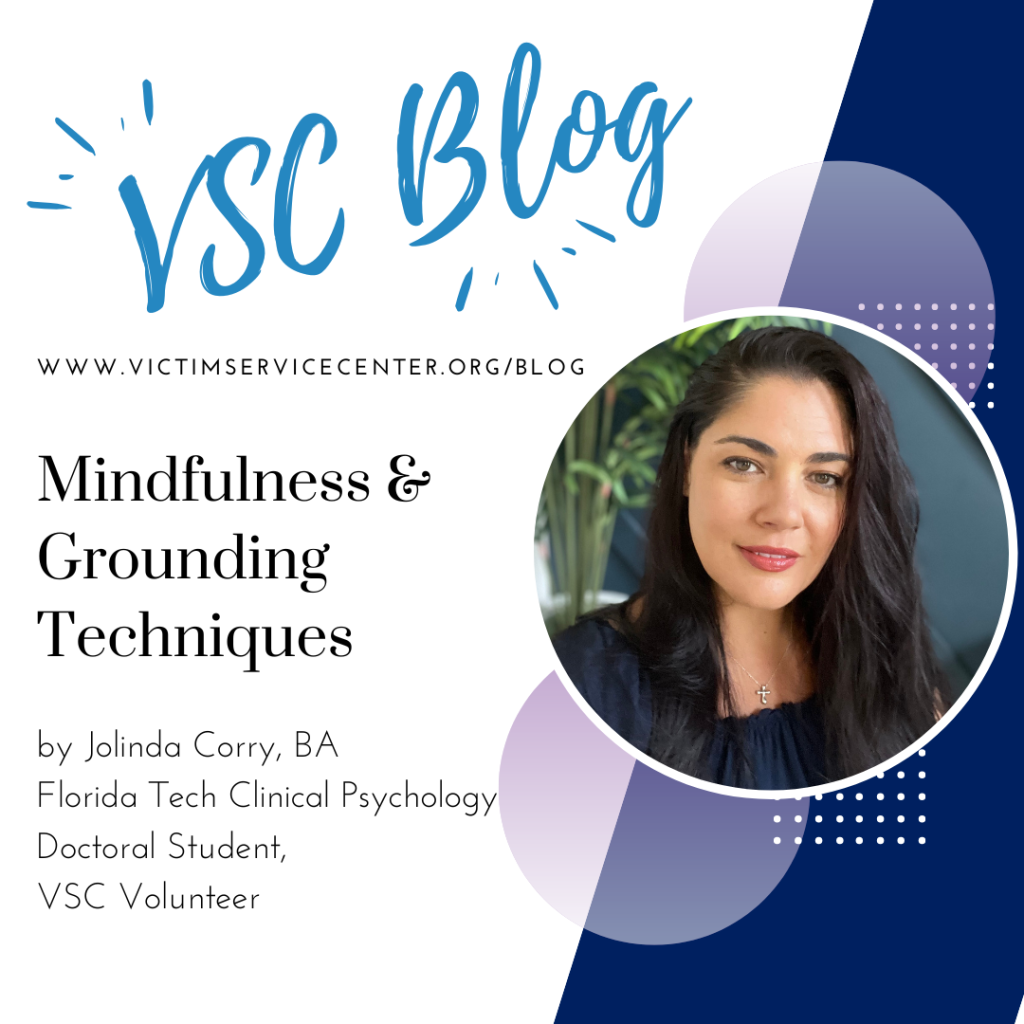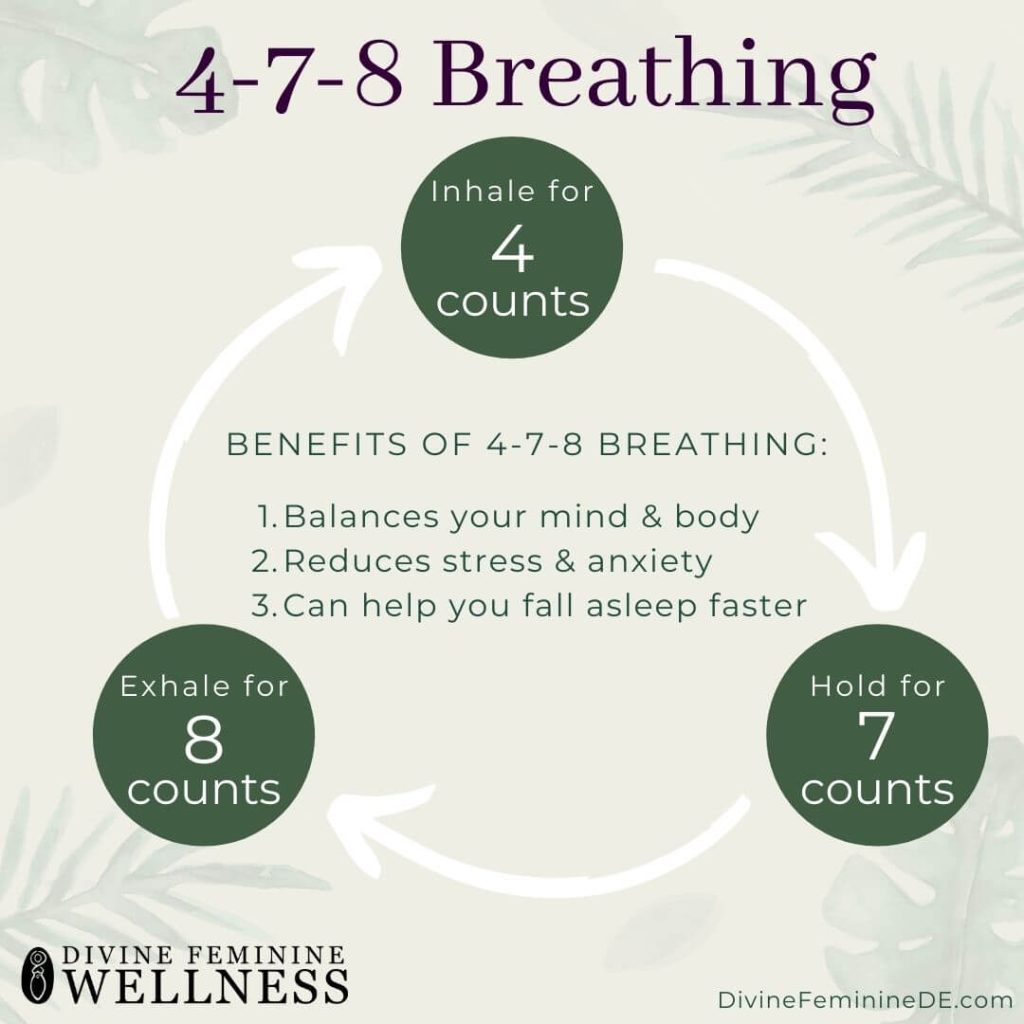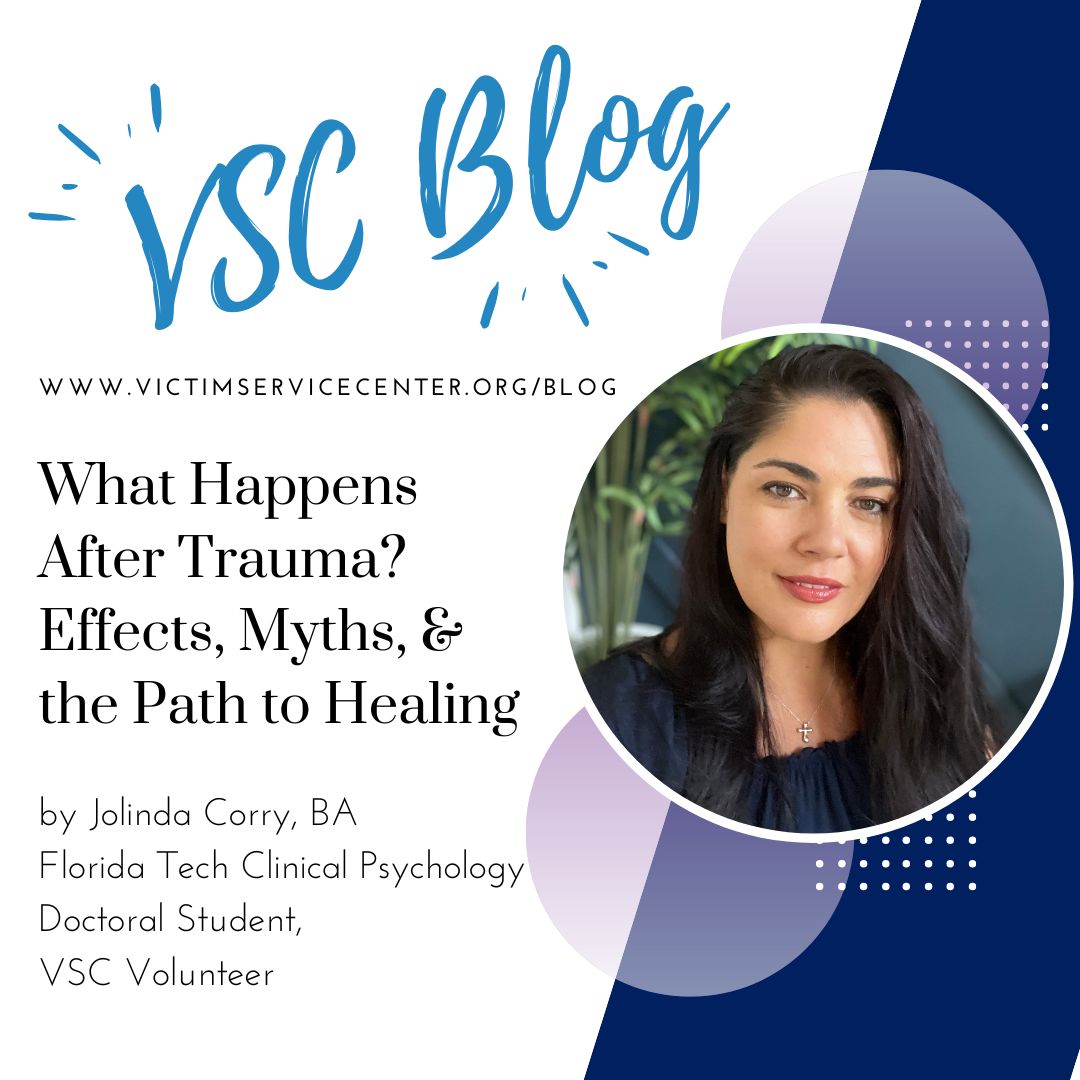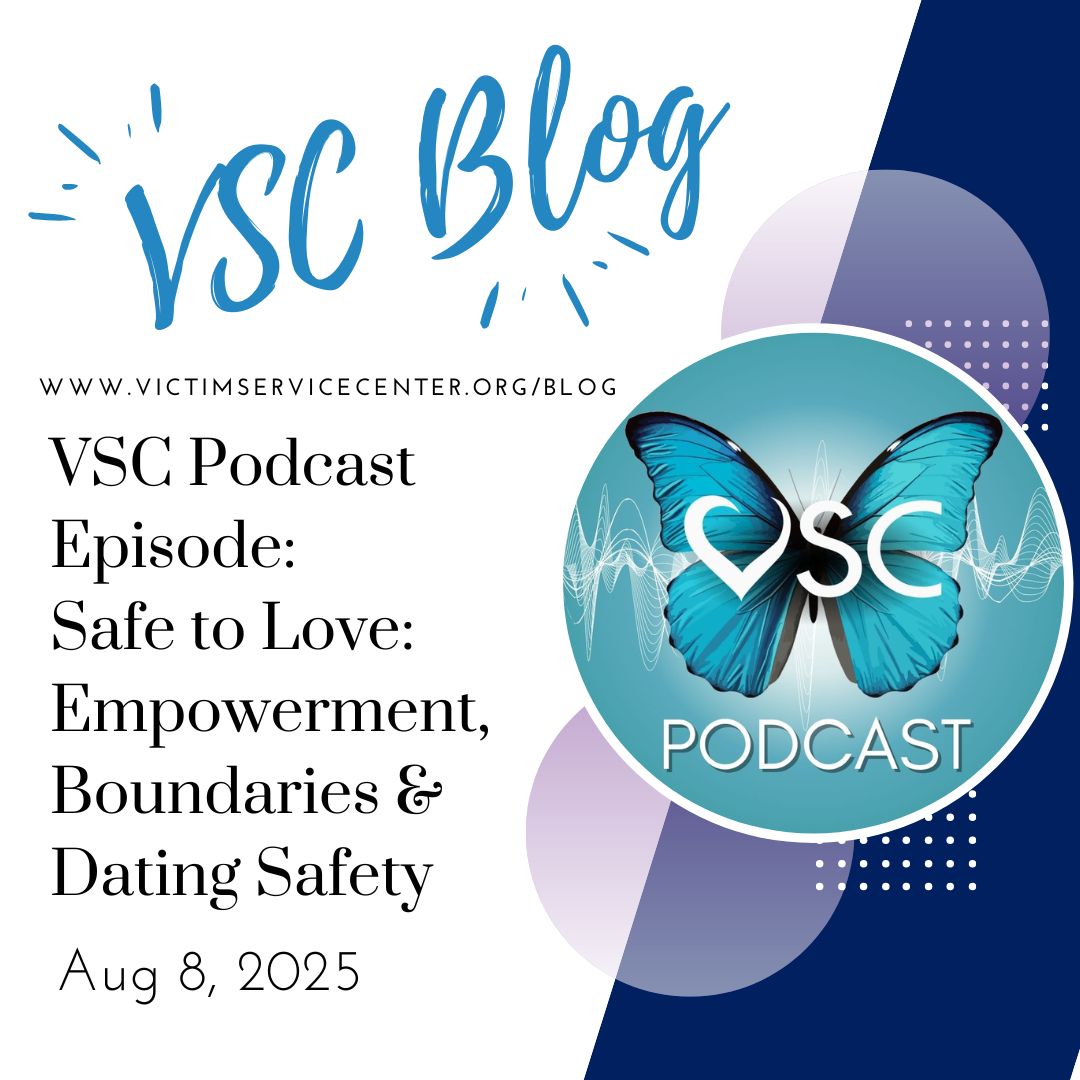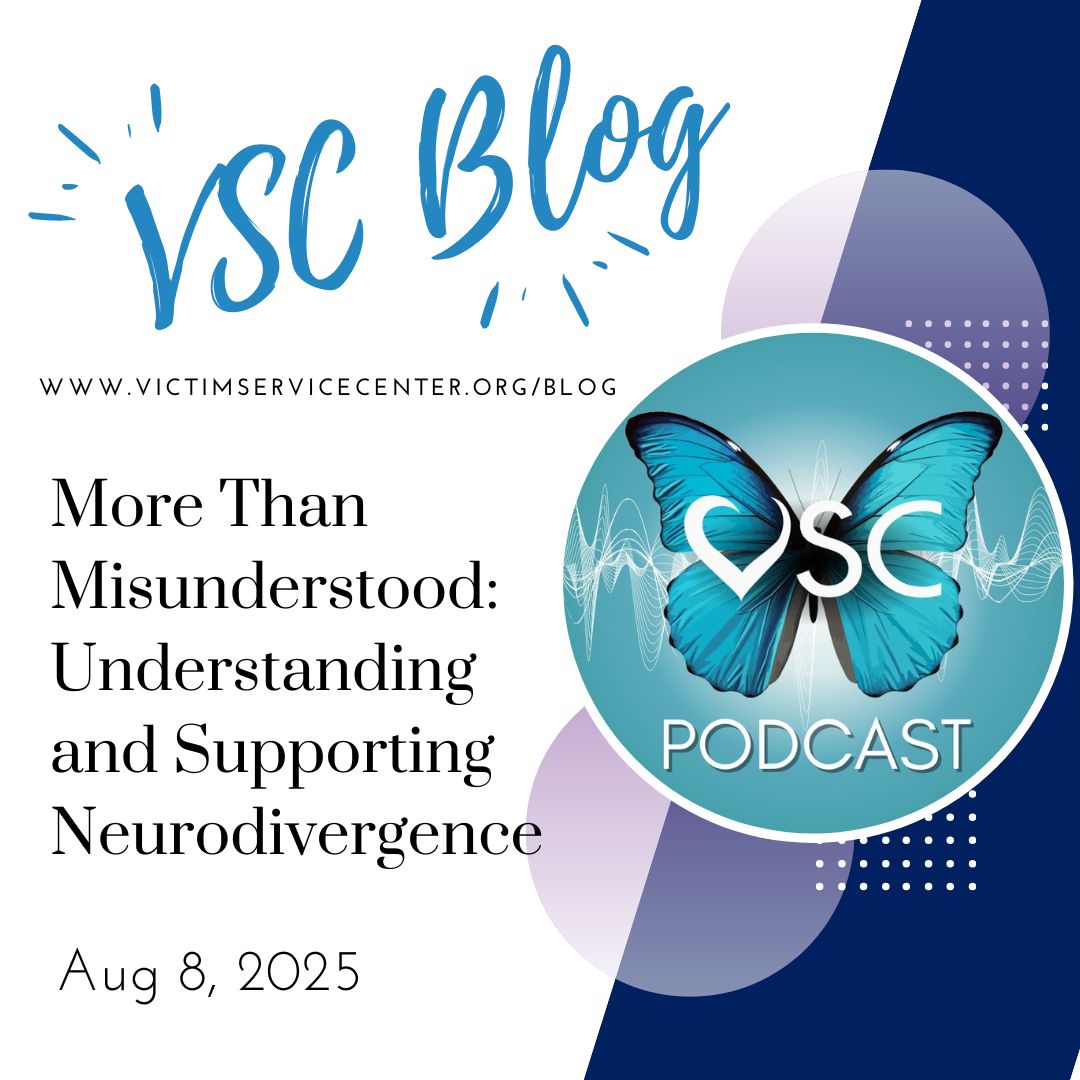By Jolinda Corry, BA, Clinical psychology doctoral student at Florida Tech (Florida Institute of Technology)
Anxiety is a normal response to stress and fear; everyone deals with some level of anxiety throughout their life. However, for many people, especially survivors of sexual or violent trauma, it can become a persistent and intense part of daily life. While traditional therapy can be beneficial for long-term healing, there are also simple techniques that can help calm the mind and body in the moment. This post looks at the science behind anxiety and introduces a few ways that are backed by research to help ease it.
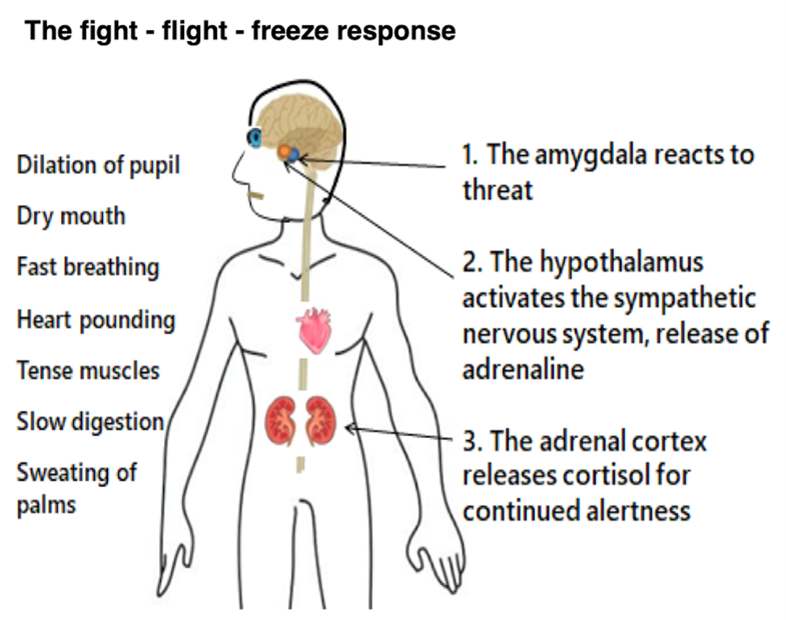
Anxiety is the natural mental and physical reaction to stressful situations, being scared, or feeling threated⁶. During stress or a perceived threat, the brain’s emotional processing center, called the amygdala, signals the body’s “fight-flight-freeze” response in the sympathetic nervous system. The sympathetic nervous system floods the body with adrenaline which can cause the person’s heartrate to increase, breathing to become quick and shallow, and they may even feel nauseous or start shaking⁶. To calm the body down, a person has to engage the “rest and digest” functions of the body, using the parasympathetic nervous system which engaging the vagus nerve which slows heart rate and promotes relaxation⁷. To do this, the body needs to feel safe again by focusing on the present moment, and by paying attention to physical sensations and breathing¹². Once our mind and body is calm, we can think more clearly which helps problem-solving and emotional regulation. One way to remember the difference between the two systems is with this analogy: the sympathetic nervous system like a symphony, it heightens the emotional state. On the other hand, the parasympathetic nervous system is like a parachute, it slows you down and grounds you.
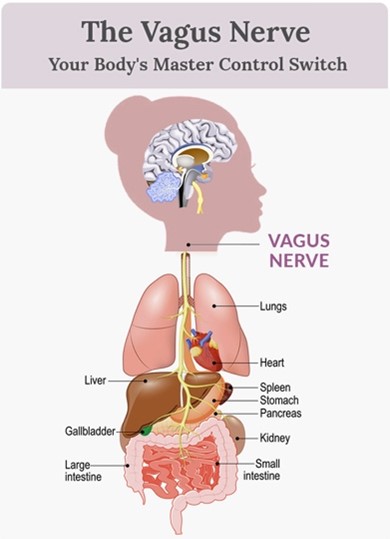
At times, anxiety may become present more than just in stressful or frightening situations. Anxiety disorders are the most common mental disorders in the United States, affecting 34% of people at some point in their life¹¹, with survivors of sexual violence reporting anxiety disorders over twice the rate of non-victims (8.73%, 3.75%, respectfully)². It’s not uncommon for survivors of sexual or violent crimes to experience emotional distress in the form of anxiety, including panic attacks, intrusive thoughts, and avoidance. Many survivors of violence find traditional therapy beneficial to work through symptoms of anxiety, however in moments of crisis or heightened emotions, many people may find the need for immediate techniques to help calm down and regulate emotions. Techniques such as mindfulness and grounding have been an effective way to help decrease anxiety attacks, particularly those that may arise unexpectedly or after a triggering situation⁸.
Grounding was developed as a way to express the mental and physical oneness with the earth by Alexander Lowen in 1950’s⁹, and has been used as a therapy technique to help bring the mind and body back to present by engaging our five senses to slow down the nervous system, reduce heart rate, release muscle tension, and boost mental clarity⁵. Mindfulness originates from Buddhist teachings and is the process of slowing thoughts in the mind; in many ways it is considered to be a state of consciousness¹⁰. Both grounding and mindfulness are powerful tools to use to reduce anxiety, as well as provide additional health and wellness benefits.
Some common Grounding and Mindfulness techniques can be found below and may be done in a variety of locations or situations, most unobservable to others around.
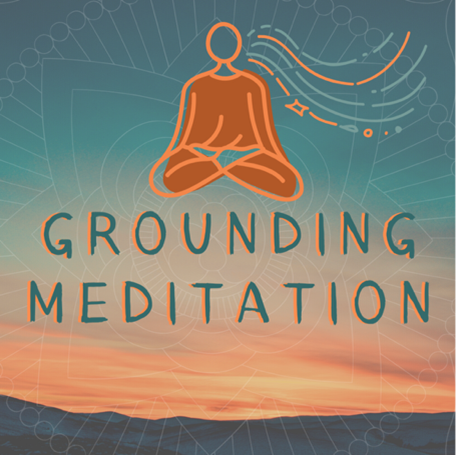
Grounding Techniques
Grounding is a way to help anchor people in the present by focusing on sensations of the body and the persons surrounding. This helps the person calm the mind, disconnect from the distressing thoughts, and feel present in their body¹²
Sensory 5-4-3-2-1 Technique
This technique helps to focus on the present moment by using the five senses. This can help calm the mind by shifting away from anxious thoughts towards things you can see, touch, hear, smell, and taste. If you are in a place that you feel comfortable, you can say each item out loud as you find it. For example, “I see a ceiling light” or “I smell coffee.”
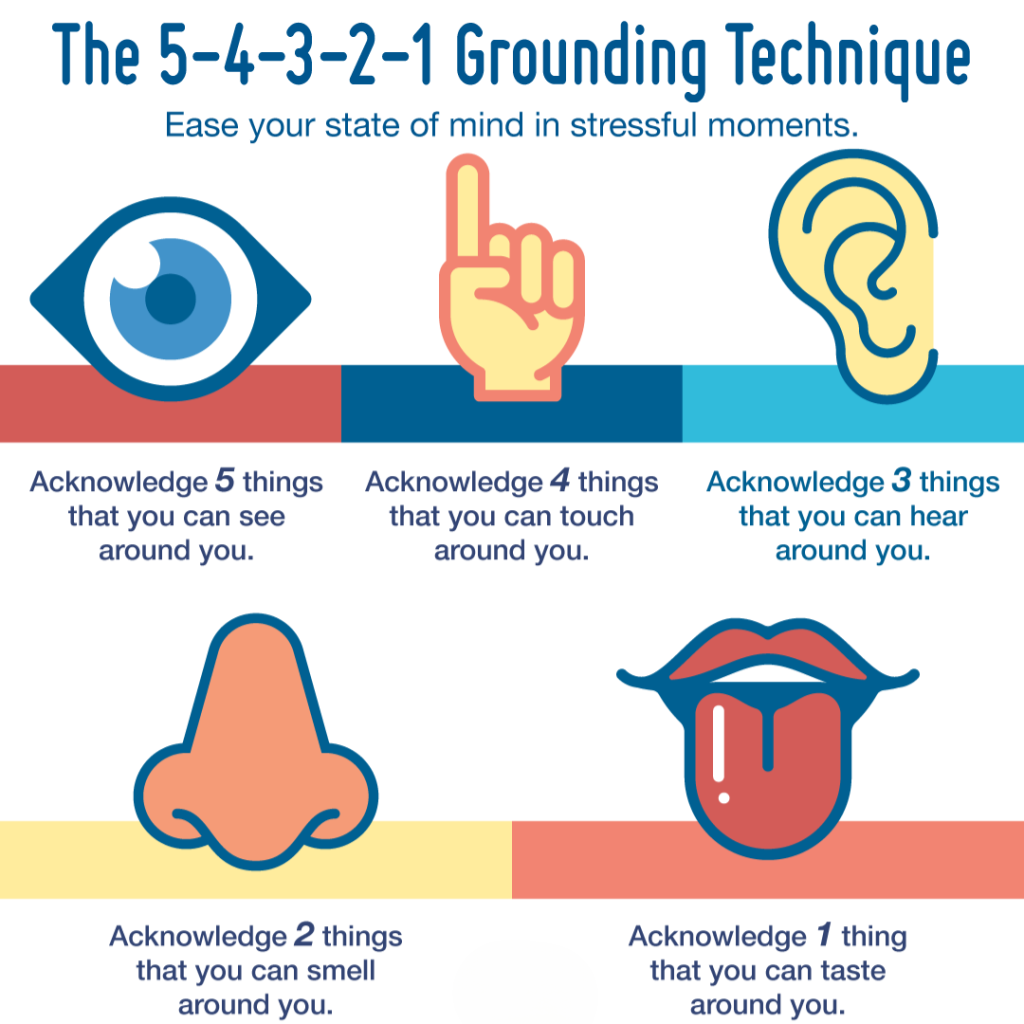
How to do it:
5 Things you can see – look around and find 5 things you can see (find 5 different patterns, colors, or textures).
4 Things you can touch – feel things around you and focus on the texture of the objects.
3 Things you can hear – listen to the sounds of your environment like cars driving, humming of lights, or even the sound of your breath.
2 Things you can smell – is there a sent to the air, a flower nearby, or a coffee if your hand.
1 Thing you can taste – can you grab a piece of gum, or drink nearby, or focus on the taste in your mouth.
Progressive Muscle Relaxation
This technique helps to reduce body tension and helps to physically relax. It is especially helpful for people who physically hold onto stress, such as clenching their jaws or tensing their shoulders.
How to do it:
- Sit or lay down in a comfortable position, preferably in a quiet place where you will not be disturbed. Take a deep breathe and relax your shoulders, continue slow deep breathing throughout the process. When ready you will tense a specific muscle group for a few seconds. Focus on the feeling of the tension, then release the muscle and focus on the feeling of the relaxed muscle. Slowly work thought your whole body.
- Start with your toes, curl them up and hold, then release.
- Then do the process with your calves, then thighs. Tighten, hold, release. Move to your buttock, then stomach, next your chest. Repeating the process of tightening, holding, and releasing.
- Next scrunch your shoulders up to your ears, hold and release. Move to your biceps, then hands, making a fist and holding then releasing. Lastly, scrunch your face as best as you can, holding then releasing.
- Repeat this process up and down your body 1 to 3 times.
Mindfulness Techniques
Mindfulness is the intentional process of focusing on the present moment, with acceptance and non-judgement. It allows you to sit in and acknowledge your thoughts and feelings without trying to change them or push them away. This can help teach both emotional regulation and attention regulation.
Dropping Anchor
Russ Harris has created the Dropping Anchor technique which helps the mind turn off “autopilot” bringing a person back to a more intentional state of mind. This will allow the mind to focus its attention on specific things instead of allowing it to obsess and worry.
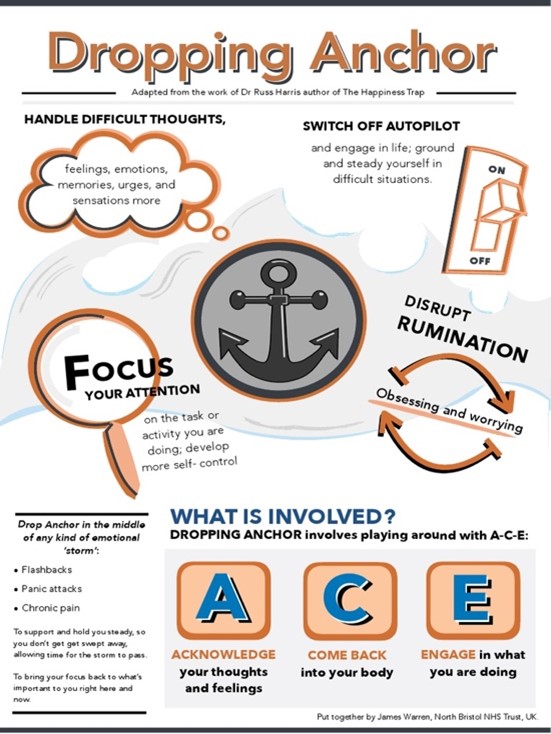
How to do it:
Using the term “ACE” you will be able to refocus your thoughts.
A: Acknowledge your thoughts and feelings
C: Come back into your body
E: Engage in what you’re doing
For free audio recordings of guided dropping anchor technique, or more about this see https://www.actmindfully.com.au/free-stuff/free-audio/
Mindful Breathing
This technique helps to calm the body by taking slow deep breaths, focusing on feeling of the air coming in and out of the body. By slowing the breaths, you help to slow the heart rate and increase oxygen which increase relaxation. Also focusing your attention on the breathing helps to break anxious thoughts and release muscle tension.
How to do it:
Find a comfortable place to sit or lie down, preferably where you will not get disturbed. If you feel comfortable, close your eyes. Focus on slow deep breaths and pay attention to the air being inhaled and exhaled. To help focus your mind you may count breaths.
Try the 4-7-8 technique.
- Inhale through your nose for 4 seconds
- Hold the breath for 7 seconds
- Exhale through your mouth slowly for 8 seconds
- Repeat the cycle for several minutes or as long as you want.
Grounding and mindfulness techniques may take some time to get used to to feel their full benefits. Practicing these techniques on a regular basis will help you find what works best for you. Also, practicing will help regulate your emotions so that you may not experience anxiety attacks as severe as before, but if you do, you will have a tool in your toolbox to help should one pop-up. Also of note, while many people have little issues when learning these techniques, some people, especially those with generalized anxiety or depression, may experience “relaxation-induced anxiety,” which is when the body increases its anxiety during relaxation. It’s important to take your time learning these techniques in a place where you feel comfortable and safe, and to remember that you can pause or stop at any time⁴.
There are many other ways to help calm the mind and body. Talk to your medical doctor, or a mental health professional about your feelings of anxiety or other emotional distress you may be under.
Sources:
¹ACT Mindfully, Workshops with Russ Harris (2009-2025). ‘Extra Bits’ eBooks, Worksheets and Handouts. https://www.actmindfully.com.au/free-stuff/free-audio/
²Gonggrijp, B., van de Weijer, S., van Dongen, J. et al. Exploring the Relationships of Crime Victimization with Depression, Anxiety, and Loneliness in Twin Families. J Dev Life Course Criminology 9, 455–482 (2023). https://doi.org/10.1007/s40865-023-00234-1
³Kelly A, Garland EL. Trauma-Informed Mindfulness-Based Stress Reduction for Female Survivors of Interpersonal Violence: Results From a Stage I RCT. J Clin Psychol. 2016 Apr;72(4):311-28. doi: 10.1002/jclp.22273. PMID: 27002222; PMCID: PMC4806391.
⁴Kim H, Newman MG. The paradox of relaxation training: Relaxation induced anxiety and mediation effects of negative contrast sensitivity in generalized anxiety disorder and major depressive disorder. J Affect Disord. 2019 Dec 1;259:271-278. doi: 10.1016/j.jad.2019.08.045. Epub 2019 Aug 19. PMID: 31450137; PMCID: PMC7288612.
⁵Koniver, L., 2024. Groudning to Treat Anxiety., Medical Reseach Archives, [online] 12(12). https://doi.org/10.18103/mra.v12i12.6024
⁶Leonard, J. (Nov. 1, 2024) What does anxiety feel like, and how does it affect the body? MedicalNewsToday. https://www.medicalnewstoday.com/articles/322510#complications
⁷Poli A, Gemignani A, Soldani F, Miccoli M. A Systematic Review of a Polyvagal Perspective on Embodied Contemplative Practices as Promoters of Cardiorespiratory Coupling and Traumatic Stress Recovery for PTSD and OCD: Research Methodologies and State of the Art. Int J Environ Res Public Health. 2021 Nov 10;18(22):11778. doi: 10.3390/ijerph182211778. PMID: 34831534; PMCID: PMC8619958.
⁸Shukla, A. (2019). A 5-Step Mindfulness Grounding Technique To Ease Anxiety & Why Mindfulness Works. Cognition Today. Retrieved from https://cognitiontoday.com/5-step-mindfulness-grounding-technique-to-ease-anxiety-why-it-works/.
⁹Shuper Engelhard, E., Pitluk, M., & Elboim-Gabyzon, M. (2021). Grounding the connection between psyche and soma: creating a reliable observation tool for grounding assessment in an adult population. Frontiers in Psychology, 12, 621958.
¹⁰Smalley, S. L., & Winston, D. (2022). Fully present: The science, art, and practice of mindfulness. Balance.
¹¹Szuhany, K. L., & Simon, N. M. (2022). Anxiety Disorders: A Review. JAMA, 328(24), 2431–2445. https://doi.org/10.1001/jama.2022.22744
¹²Transpersonal Psychology (2014). Mindfulness and Trauma Recovery: Grounding Techniques. https://transpersonal-psychology.iresearchnet.com/mindfulness-and-contemplative-practices/mindfulness-and-trauma-recovery-grounding-techniques/

